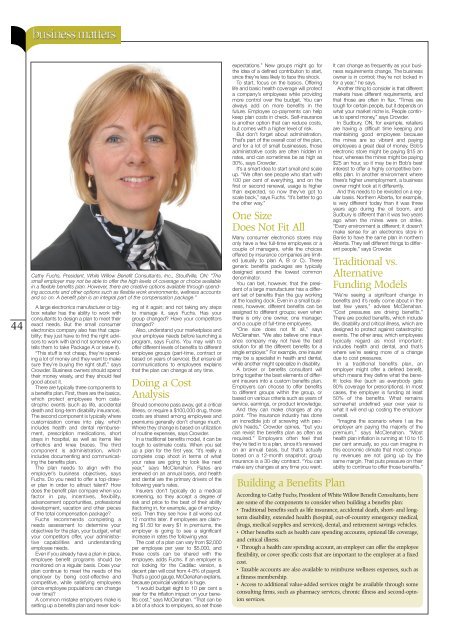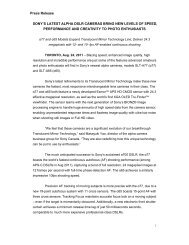right here - Canadian Imaging Blog - Vistek
right here - Canadian Imaging Blog - Vistek
right here - Canadian Imaging Blog - Vistek
Create successful ePaper yourself
Turn your PDF publications into a flip-book with our unique Google optimized e-Paper software.
44<br />
Cathy Fuchs, President, While Willow Benefit Consultants, Inc., Stouffville, ON: “The<br />
small employer may not be able to offer the high levels of coverage or choice available<br />
in a flexible benefits plan. However, t<strong>here</strong> are creative options available through spending<br />
accounts and other options such as flexible work environments, wellness accounts<br />
and so on. A benefit plan is an integral part of the compensation package.”<br />
A large electronics manufacturer or bigbox<br />
retailer has the ability to work with<br />
consultants to design a plan to meet their<br />
exact needs. But the small consumer<br />
electronics company also has that capability;<br />
they just have to find the <strong>right</strong> advisors<br />
to work with (and not someone who<br />
tells them to take Package A or leave it).<br />
“This stuff is not cheap, they’re spending<br />
a lot of money and they want to make<br />
sure they’re buying the <strong>right</strong> stuff,” says<br />
Crowder. Business owners should spend<br />
their money wisely, and they should feel<br />
good about it.<br />
T<strong>here</strong> are typically three components to<br />
a benefits plan. First, t<strong>here</strong> are the basics,<br />
which protect employees from catastrophic<br />
events (such as life, accidental<br />
death and long-term disability insurance).<br />
The second component is typically w<strong>here</strong><br />
customization comes into play, which<br />
includes health and dental reimbursement,<br />
prescription medications, short<br />
stays in hospital, as well as items like<br />
orthotics and knee braces. The third<br />
component is administration, which<br />
includes documenting and communicating<br />
the benefits plan.<br />
The plan needs to align with the<br />
employer’s business objectives, says<br />
Fuchs. Do you need to offer a top-drawer<br />
plan in order to attract talent? How<br />
does the benefit plan compare when you<br />
factor in pay, incentives, flexibility,<br />
advancement opportunities, professional<br />
development, vacation and other pieces<br />
of the total compensation package?<br />
Fuchs recommends completing a<br />
needs assessment to determine your<br />
objectives for the plan, your budget, what<br />
your competitors offer, your administrative<br />
capabilities and understanding<br />
employee needs.<br />
Even if you already have a plan in place,<br />
employee benefit programs should be<br />
monitored on a regular basis. Does your<br />
plan continue to meet the needs of the<br />
employer by being cost-effective and<br />
competitive, while satisfying employees<br />
(since employee populations can change<br />
over time)?<br />
A common mistake employers make is<br />
setting up a benefits plan and never look-<br />
ing at it again; and not taking any steps<br />
to manage it, says Fuchs. Has your<br />
group changed? Have your competitors<br />
changed?<br />
Also, understand your marketplace and<br />
your employee needs before launching a<br />
program, says Fuchs. You may wish to<br />
offer different levels of benefits to different<br />
employee groups (part-time, contract or<br />
based on years of service). But ensure all<br />
communications to employees explains<br />
that the plan can change at any time.<br />
Doing a Cost<br />
Analysis<br />
Should someone pass away, get a critical<br />
illness, or require a $100,000 drug, those<br />
costs are shared among employees and<br />
premiums generally don’t change much.<br />
W<strong>here</strong> they change is based on utilization<br />
of routine expenses, says Crowder.<br />
In a traditional benefits model, it can be<br />
tough to estimate costs. When you set<br />
up a plan for the first year, “it’s really a<br />
complete crap shoot in terms of what<br />
your rates are going to look like next<br />
year,” says McClenahan. Rates are<br />
renewed on an annual basis, and health<br />
and dental are the primary drivers of the<br />
following year’s rates.<br />
Insurers don’t typically do a medical<br />
screening, so they accept a degree of<br />
risk and price to the best of their ability<br />
(factoring in, for example, age of employees).<br />
Then they see how it all works out<br />
12 months later. If employees are claiming<br />
$1.50 for every $1 in premiums, the<br />
employer is going to see a significant<br />
increase in rates the following year.<br />
The cost of a plan can vary from $2,000<br />
per employee per year to $5,000, and<br />
these costs can be shared with the<br />
employee, adds Fuchs. If an employer is<br />
not looking for the Cadillac version, a<br />
decent plan will cost from 4-8% of payroll.<br />
That’s a good gauge, McClenahan explains,<br />
because provincial variation is huge.<br />
“I would budget eight to 10 per cent a<br />
year for the inflation impact on your benefits<br />
cost,” says McClenahan. “That can be<br />
a bit of a shock to employers, so set those<br />
expectations.” New groups might go for<br />
the idea of a defined contribution to start,<br />
since they’re less likely to face this shock.<br />
To start, focus on the basics. Offering<br />
life and basic health coverage will protect<br />
a company’s employees while providing<br />
more control over the budget. You can<br />
always add on more benefits in the<br />
future. Employee co-payments can help<br />
keep plan costs in check. Self-insurance<br />
is another option that can reduce costs,<br />
but comes with a higher level of risk.<br />
But don’t forget about administration.<br />
That’s part of the overall cost of the plan,<br />
and for a lot of small businesses, those<br />
administrative costs are often hidden in<br />
rates, and can sometimes be as high as<br />
30%, says Crowder.<br />
It’s a smart idea to start small and scale<br />
up. “We often see people who start with<br />
100 per cent of everything, and on the<br />
first or second renewal, usage is higher<br />
than expected, so now they’ve got to<br />
scale back,” says Fuchs. “It’s better to go<br />
the other way.”<br />
One Size<br />
Does Not Fit All<br />
Many consumer electronics stores may<br />
only have a few full-time employees or a<br />
couple of managers, while the choices<br />
offered by insurance companies are limited<br />
(usually to plan A, B or C). These<br />
generic benefits packages are typically<br />
designed around the lowest common<br />
denominator.<br />
You can bet, however, that the president<br />
of a large manufacturer has a different<br />
set of benefits than the guy working<br />
at the loading dock. Even in a small business,<br />
however, different benefits can be<br />
assigned to different groups; even when<br />
t<strong>here</strong> is only one owner, one manager,<br />
and a couple of full-time employees.<br />
“One size does not fit all,” says<br />
McClenahan. “We also believe one insurance<br />
company may not have the best<br />
solution for all the different benefits for a<br />
single employer.” For example, one insurer<br />
may be a specialist in health and dental,<br />
while another might specialize in disability.<br />
A broker or benefits consultant will<br />
bring together the best elements of different<br />
insurers into a custom benefits plan.<br />
Employers can choose to offer benefits<br />
to different groups within the group, or<br />
based on various criteria such as years of<br />
service, earnings, or product knowledge.<br />
And they can make changes at any<br />
point. “The insurance industry has done<br />
an incredible job of screwing with people’s<br />
heads,” Crowder opines, “but you<br />
can revisit the benefits plan as often as<br />
required.” Employers often feel that<br />
they’re tied in to a plan, since it’s renewed<br />
on an annual basis, but that’s actually<br />
based on a 12-month snapshot; group<br />
insurance is a 30-day contract. “You can<br />
make any changes at any time you want.<br />
Building a Benefits Plan<br />
It can change as frequently as your business<br />
requirements change. The business<br />
owner is in control; they’re not locked in<br />
for a year,” he says.<br />
Another thing to consider is that different<br />
markets have different requirements, and<br />
that those are often in flux. “Times are<br />
tough for certain people, but it depends on<br />
what your market niche is. People continue<br />
to spend money,” says Crowder.<br />
In Sudbury, ON, for example, retailers<br />
are having a difficult time keeping and<br />
maintaining good employees because<br />
the mines are so vibrant and paying<br />
employees a great deal of money. Bob’s<br />
electronic store might be paying $15 an<br />
hour, w<strong>here</strong>as the mines might be paying<br />
$25 an hour, so it may be in Bob’s best<br />
interest to offer a highly competitive benefits<br />
plan. In another environment w<strong>here</strong><br />
t<strong>here</strong>’s higher unemployment, a business<br />
owner might look at it differently.<br />
And this needs to be revisited on a regular<br />
basis. Northern Alberta, for example,<br />
is very different today than it was three<br />
years ago during the oil boom, and<br />
Sudbury is different than it was two years<br />
ago when the mines were on strike.<br />
“Every environment is different; it doesn’t<br />
make sense for an electronics store in<br />
Barrie to have the same plan in northern<br />
Alberta. They sell different things to different<br />
people,” says Crowder.<br />
Traditional vs.<br />
Alternative<br />
Funding Models<br />
“We’re seeing a significant change in<br />
benefits and it’s really come about in the<br />
last few years,” advises McClenahan.<br />
“Cost pressures are driving benefits.”<br />
T<strong>here</strong> are pooled benefits, which include<br />
life, disability and critical illness, which are<br />
designed to protect against catastrophic<br />
events. The other area; which employees<br />
typically regard as most important;<br />
includes health and dental, and that’s<br />
w<strong>here</strong> we’re seeing more of a change<br />
due to cost pressures.<br />
In a traditional benefits plan, an<br />
employer might offer a defined benefit,<br />
which means they define what the benefit<br />
looks like (such as everybody gets<br />
80% coverage for prescriptions). In most<br />
cases, the employer is funding at least<br />
50% of the benefits. What remains<br />
somewhat undefined year over year is<br />
what it will end up costing the employer<br />
overall.<br />
“Imagine the scenario w<strong>here</strong> I as the<br />
employer am paying the majority of the<br />
premium,” says McClenahan. “Most<br />
health plan inflation is running at 10 to 15<br />
per cent annually, so you can imagine in<br />
this economic climate that most company<br />
revenues are not going up by the<br />
same margin. That puts pressure on their<br />
ability to continue to offer those benefits.”<br />
According to Cathy Fuchs, President of White Willow Benefit Consultants, <strong>here</strong><br />
are some of the components to consider when building a benefits plan:<br />
• Traditional benefits such as life insurance, accidental death, short- and longterm<br />
disability, extended health (hospital, out-of-country emergency medical,<br />
drugs, medical supplies and services), dental, and retirement savings vehicles.<br />
• Other benefits such as health care spending accounts, optional life coverage,<br />
and critical illness.<br />
• Through a health care spending account, an employer can offer the employee<br />
flexibility, or cover specific costs that are important to the employer at a fixed<br />
cost.<br />
• Taxable accounts are also available to reimburse wellness expenses, such as<br />
a fitness membership.<br />
• Access to additional value-added services might be available through some<br />
consulting firms, such as pharmacy services, chronic illness and second-opinion<br />
services.



